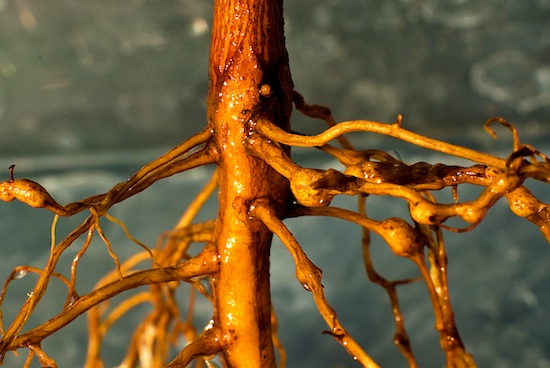In addition to low prices, controlling nematodes is top priority for Georgia cotton farmers. But with one effective control method being taken away and a new one in short supply, University of Georgia researchers and Cooperative Extension agents are working quickly to help farmers find a solution.
Nematodes are microscopic worms that can have a devastating effect on cotton and other row crops. Root-knot nematodes cause the most problems because of the wide range of their row crop hosts.
“Behind water and soil nutrients, nematodes are the biggest limiting factor in terms of yield in my county. Cotton farmers are always trying to find something to help control nematodes,” said Andrew Shirley, the UGA Extension agricultural and natural resources agent in Mitchell County.
Since the aldicarb pesticide Temik was phased out of use a few years ago, growers have been searching for a replacement for nematode control, UGA Extension plant pathologist Bob Kemerait said.
“In our cotton ground, from a survey we conducted 10 years ago, we know 75 percent of fields have some level of parasitic nematodes,” Kemerait said. “Finding the right mix between resistant varieties and nematicides and crop rotations is what we try to do here at the University of Georgia to help the growers out.”
Telone
One option is Telone, a soil fumigant that can control nematodes. However, Kemerait estimates it would cost $60 per acre to apply, a high cost for farmers who are trying to limit expenses when cotton prices are currently listed at just 64 cents per pound.
Colquitt County agricultural and natural resources agent Jeremy Kichler estimates growers in his county who use Telone have to produce an additional 100 pounds per acre just to break even, assuming 60 cent cotton and Telone costing $60 per acre.
Velum Total
Velum Total is another option. Introduced this year, Velum Total is an in-furrow liquid spray applied to seeds at planting. The chemical was in limited supply this year but could be part of the answer to cotton farmers’ nematode control problem, Kemerait said.
“I am hopeful that Velum Total will give growers a new tool in their fight against nematodes. Velum Total will not replace the strength of Telone in fields where damage from nematodes is severe, but I expect the efficacy of Velum Total to exceed that of a seed treatment and to be more in line with the historical nematode control provided by Temik,” he said.
Like Temik, Velum Total is for management of nematodes and thrips.
At UGA, Kemerait and Shirley are coordinating a trial this year to further examine Velum Total’s effectiveness.
“The hope is that this chemical will provide the control that these farmers are looking for,” Shirley said.
Kemerait estimates that there was enough Velum Total available this year to meet 20 to 25 percent of Georgia farmers’ needs. A full release of the chemical is planned for 2016.
Colquitt County is traditionally one of the top cotton-producing counties in Georgia. Kichler estimates that the majority of the county’s cotton acreage has some level of yield loss from nematodes.
“Southern root-knot nematodes are a big problem down here. Growers are dealing with close cotton rotations. Trying to manage nematodes can be challenging, especially after losing a management tool like Temik. In order to help growers manage nematodes, we’re looking at seed treatments, resistant cotton varieties and crop rotations,” Kichler said. “When you have an infrastructure that’s dedicated to cotton, it’s hard to change to other crops.”
Fall sampling
Kichler believes an effective management practice for Extension agents is to educate growers during the fall by conducting nematode sampling after harvest. Having nematode samples analyzed allows county agents to evaluate how big of a problem producers have with nematodes statewide.
“Nematode sampling will tell growers what type of nematode and what level of nematodes are present in their field. If we have that information, then they can go to their county agent and say, ‘I have this level of nematodes and this type of nematode, what are my management options? Can we go with a seed treatment next year, or do I need to go with Telone?’” Kichler said. “Right now we’re kind of in survival mode. We’re trying to figure out what inputs will make us the most money while cutting corners and not affecting yield.”
A reduction in cotton acres
One result of the low cotton prices is a reduction in Georgia’s cotton acres. While all commodity prices are low, the best opportunity for profit, due to provisions in the most recent Farm Bill, lies with peanuts. Georgia peanut farmers were expected to increase acres to as much as 750,000, up from 430,000 last year. Farmers who annually rotate cotton and peanuts were expected to grow more peanuts this year.
Cotton remains a valuable crop in Georgia and the U.S. The United States Department of Agriculture predicts 9.55 million acres of cotton will be grown this year; 1.1 million of those acres are in Georgia.








